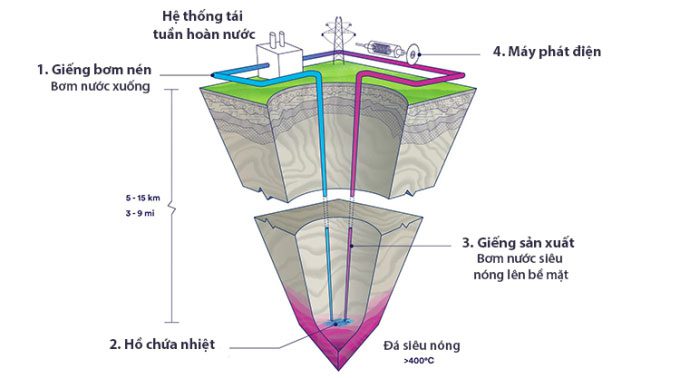Research organizations are seeking to harness the abundant energy from superheated rocks located 3.2 to 19.3 kilometers beneath the Earth’s surface.
The Earth’s core is extremely hot, reaching temperatures of up to 6,000℃ at its center. However, by drilling down to depths where rocks are heated to 400℃, we can convert this thermal energy into a massive, carbon-free energy source that is always available, according to a report released last weekend by the Clean Air Task Force (CATF), a non-profit climate organization based in Boston, USA.
CATF commissioned the Geothermal Energy Research Organization, a non-profit geothermal entity, and the international clean energy consulting firm LucidCatalyst to calculate the costs of commercial-scale superheated rock electricity. They estimate that it could ultimately cost between $20 and $35 per megawatt-hour (MWh), making it competitive with current natural gas power plant prices.
That is a vision, not yet a reality. Currently, we do not have any systems capable of harnessing superheated rock energy, but funding is flowing into research projects and companies that are beginning to work on developing this technology, said geologist Bruce Hill from CATF, the report’s author, in an interview with CNBC.
The report states that superheated rock energy could be commercialized by the 2030s. It represents a nearly limitless clean energy source, making investments worthwhile.

Simulation of clean energy extraction from superheated rocks. (Photo: CATF)
The first step in realizing superheated rock electricity is to drill deep into the Earth, ranging from a few kilometers to tens of kilometers, depending on the location. At the edge of tectonic plate boundaries or areas with recent volcanic activity, superheated rocks may be found as shallow as 3.2 kilometers, but in continental interiors, they can be as deep as 19.3 kilometers.
The deepest drilling ever conducted on Earth reached nearly 13 kilometers in the Kola Peninsula of Russia in the 1970s, but the rocks there were not hot enough to be considered superheated. Rocks begin to melt at temperatures ranging from 600℃ to 1,000℃, so the temperature range for superheated rocks is calculated to be between 400℃ and 550℃, according to Hill.
Once drilled deep enough, water will be pumped down the well and return to the surface in a superheated state, also known as “supercritical,” possessing properties of both gas and liquid simultaneously. This supercritical water will then be directed to a power generator.
CATF conducted its first test near a volcano in Iceland, where the Krafla well produced naturally superheated water at a temperature of 452℃, with an estimated energy production potential of 36 MW. Iceland is particularly suitable for geothermal energy research because it is located where the North American and Eurasian tectonic plates are pulling apart.
In addition to Iceland, Italy, Japan, New Zealand, and the United States are leaders in the field of superheated rock geothermal energy. Other regions and countries at the edges of tectonic plates, such as Central America, Indonesia, Kenya, and the Philippines, are also making some developments.
For superheated geothermal energy to be commercialized and widely deployed, many new technologies will be required, including methods for rapid deep drilling, heat-resistant materials and tools, as well as thermal reservoirs deep within hot dry rocks. These represent technical challenges, but they are not impossible, CATF emphasizes.


















































